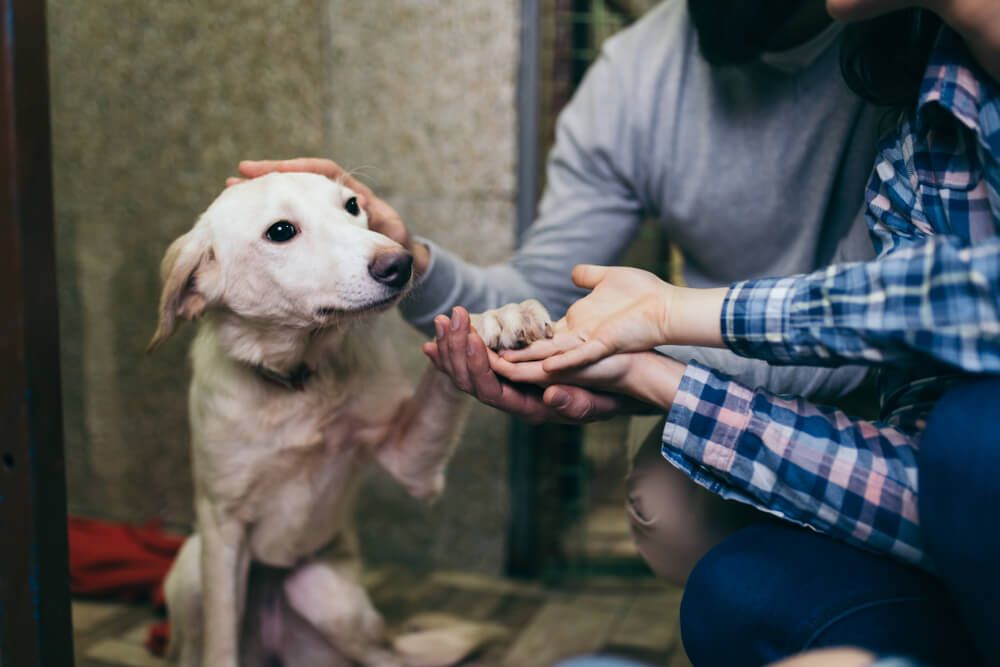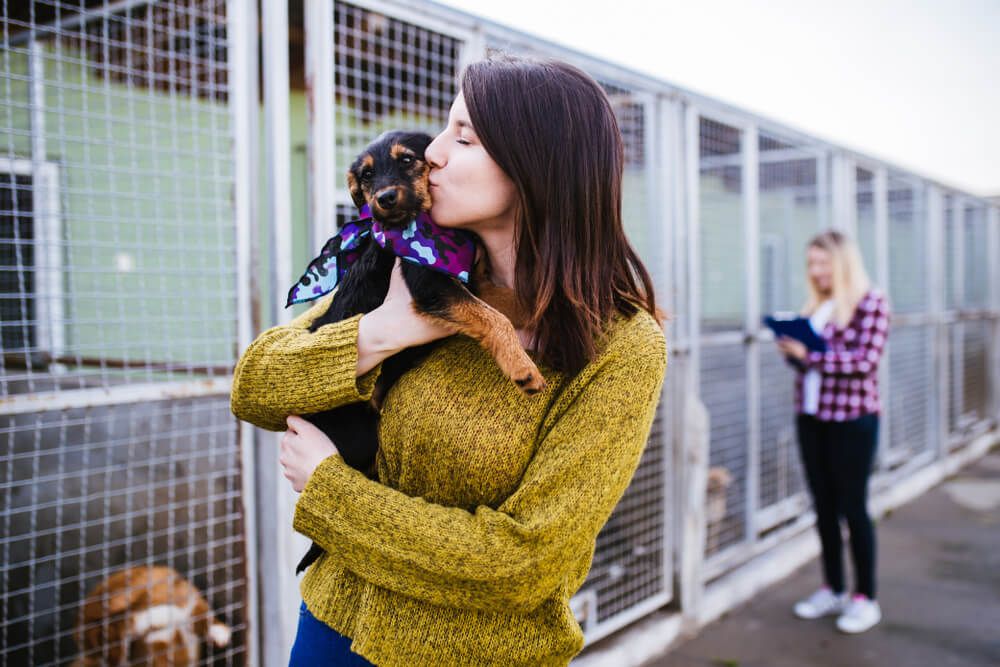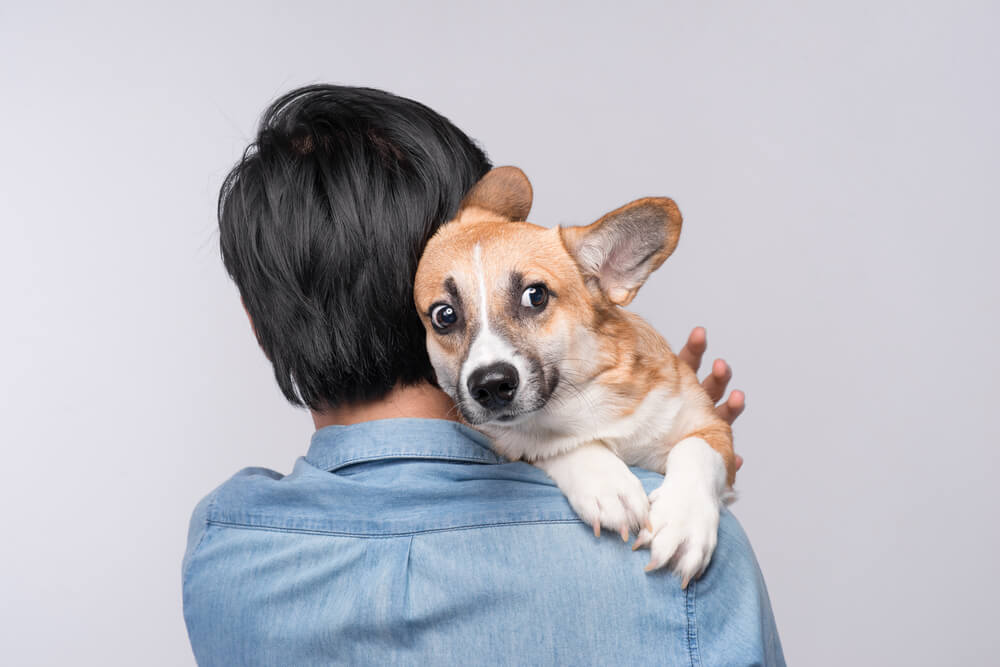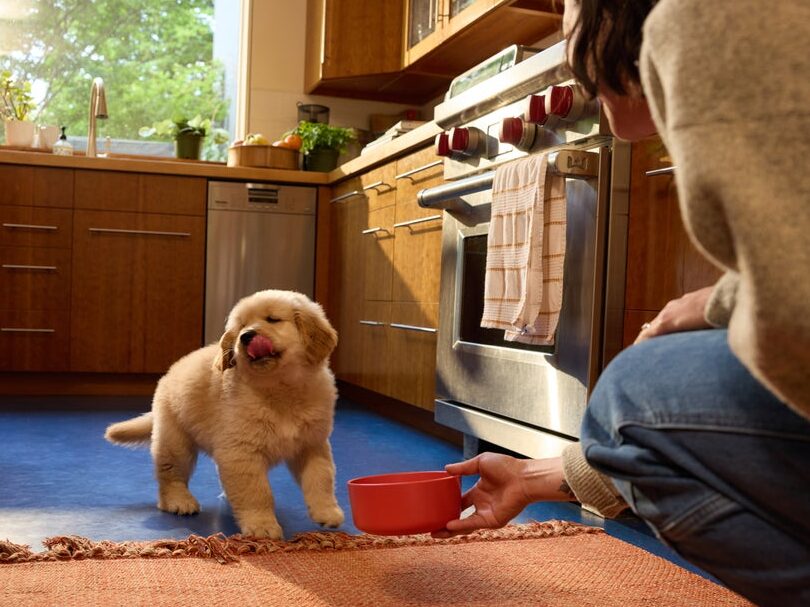Hey Ollie blog readers! We’re offering you an exclusive 60% OFF your starter box! Try now!
So, you’re looking to add a new member to your family and #adoptdontshop is your priority. You don’t think you want a young puppy and are looking for an older dog. You start looking at local shelters and rescues for the perfect pup. We’ve put together some things to consider, what to look for, and how to make the transition a success so that you can focus on supporting your new best friend the best way possible.

Before you go to the shelter to meet pups
1. Consider your lifestyle
Dogs end up in shelters and rescues for many reasons. Some of these reasons include families needing to relocate, owners, passing away or becoming terminally ill, dogs being dumped as strays or surrendered for a variety of reasons. Sometimes the shelter or rescue will know a lot about a dog’s background and history and other times they will not. Keep this in mind when meeting dogs. There is the perfect pup out there no matter what you are looking for. Knowing what you want will help, but be prepared to be patient if you are looking for a specific dog or breed.
To find the right dog for you, consider your lifestyle. Do you like to walk or hike or do you prefer to Netflix and Chill on the couch? If you prefer the latter a smaller breed dog might be best, like a Pug or Shih Tzu. If you are more active, you might consider a working dog like a hound mix, Australian Cattle Dog, or Border Collie. Working dogs thrive when they have plenty of outdoor space, exercise, and a job to do. All things you want to keep in mind when meeting dogs.
You may also want to consider where you live, what kind of car you drive and the type of dog you want. If you live in an apartment with steps, you may want to consider a dog under 50 pounds in case you need to carry them up and down the steps for any reason. If you like fluffier dogs you may not want to meet bully breeds or terriers since they tend to have flat coats. It’s okay to have an idea of what you want and change your mind though!
It is important to also have an idea of the age of the dog you want to adopt. Some people really want a young puppy so they can control all of the training and socialization. Others prefer a dog around 1-2 years old, this way they are out of the teething phase and don’t have as much puppy energy. For other families, they want a middle-aged (5-7 years old) or senior citizen. Dogs around 9-12 months may be the most challenging to adopt as they are in their “teenage years”. According to experienced trainers and foster parents, this is the time that many pups are returned to the shelter for “behavior issues”. If you bring home a young dog or a teenager, be prepared to work through these issues! Like human teenagers, most of these issues can be handled at home (with help from a trusted pro).
2. Do your homework
Before you meet any dogs, you may want to research different breeds that fit your lifestyle and abilities. If you see a photo of a dog you like, learn more about the breed, potential health issues, and the specific dog or dog’s situation. How old are they? Do they have any current health issues? What issues are they at risk for in the future? Some breeds are prone to skin issues, joint issues, or cancers. All of these may require preventative measures or medical treatment as your dog ages. You want to ensure you are financially prepared for this.
3. Find a local trainer and vet (or ask for recommendations)
To help your dog settle into your home smoothly, you may want to have some professionals on standby. Learn about your options for trainers and vets so that you are ready to go when you bring your pup home. We’ll talk more about how to transition but before you pick your new dog, you want to make sure you’re prepared for any issues that come up. As we’ve already mentioned, the shelter is a stressful place so your pup may need some time and help to decompress and transition to your home.
4. Be prepared!
Shelters and rescues generally want dogs out of their care ASAP. This can either be via adoption or through foster care. Shelters work with short term fosters to give pups a break and longer-term fosters for dogs who are poor candidates for the shelter. This could be due to age, recovering from a medical condition, or even personality. There are two main reasons shelters want pups out. First, the shelter is a stressful environment for dogs. They can be loud, busy and the dog may spend most of their day in a kennel. Second, if the kennel space becomes available that means they can save another pup. If you head to the shelter and fall in love, you may need to be prepared to take the dog right away or within a day or two. If you can’t someone else may come in and adopt the dog you wanted. For open intake shelters, some dogs may be ‘timestamped’ for euthanasia should the shelter be full. There are many factors considered when deciding which dogs to timestamp. These could include age, health, breed, and amount of time the dog has been in the shelter. Talk with the shelter or rescue to come up with the best plan to help you transition the dog to your care smoothly.
Be prepared to hear that if you don’t take the dog they may be euthanized, adopted, or unavailable when you come back. If you really want the dog, you may have to take them ASAP. This means that if you are looking at dogs before a vacation or other time you may not be able to focus on acclimating the dog to your home and routine it might not be the right time to adopt. You will have to make the best decision both for you and the dog.
5. Have a conversation with all family members about their roles in caretaking
Before the dog comes home, you and your family should have a conversation about what you will do in the event that behavioral issues arise. What happens if the dog has severe fears, separation anxiety, or resource guards? If you have another pet in your home, what if you find they aren’t getting along or your other pet is becoming stressed. Have a plan in advance for what you are and are not willing to do in these situations. Having everyone on the same page ahead of time will help you manage expectations for everyone in your home. Some rescues have a 2-week trial period to help a dog settle in and ensure a good match. Most rescues and shelters will contractually obligate you to return the dog to them if you need to rehome them for any reason. While we hope it never comes to this, we understand that sometimes this happens for valid reasons. It is not an easy decision and you need to do what is best for everyone in your home as well as the dog.

Going to meet the dogs
Every shelter and rescue has different policies and procedures. Make sure you have reached out to the shelter or visited their website to understand their policies and requirements to adopt. Due to COVID-19 some shelters are now appointment only and may stay that way for the foreseeable future. You might have to pre-qualify for adoption by filling out paperwork and getting references before you meet dogs.
You also want to make sure you know what adoption fees are and what is included. Sometimes all vaccines (up to the point you adopt) are included as well as spay/neuter surgery. Some shelters require the dog to be spayed or neutered before they can be adopted. Others require you to have the dog spayed or neutered at the appropriate time at your expense. Prices for these surgeries can vary so be sure to know what you are responsible for.
In addition to meeting dogs at the shelter, you may also have the opportunity to meet dogs in foster care. Foster parents can be amazing resources. Since they have spent 24/7 with the dogs for days, weeks, or even months, they may be able to give more insight into the dog’s personalities, likes, and dislikes. If the foster family has other pets or kids, they will also know how the dog does with them. If you have other pets or children this insight will be very helpful in ensuring that you are choosing a dog that is a good fit for your family.
Foster parents may be able to choose the adopters (as long as they meet all criteria from the shelter or rescue). Some foster parents fall so in love with their foster that they opt to keep them. This is sometimes referred to as a foster failure (the best kind of failure if you ask us).
If you are meeting dogs in the shelter, keep in mind that the dogs may be more stressed. Their true personalities may not come through in the shelter environment. Even so, learn as much as you can from the adoption coordinators or volunteers. There should be people handling the dogs and trying to help them socialize as much as possible. Be aware that some dogs bark or seem to be on alert when you come through the shelter and others may be more shut down from the stress of the environment. Like people, all dogs respond to stress differently.
If you have a dog or kids in the home, be sure to bring them along for a meet and greet. While there are no guarantees, this will help you see how they get along. Many shelters will have a special area to do these introductions in, so you can introduce the dogs on neutral territory.
Be patient, you may have to meet a few dogs before you find the perfect fit. Remember that this dog will be part of your family and your best friend as long as they live.

Bringing your dog home
When you bring your dog home from the shelter they will need some time to decompress. Dawn Heiderscheidt, a trainer at Philly Unleashed, in Philadelphia, PA, and her husband adopted Odin, a mixed breed from a shelter. Odin was believed to be about 3 years old and was found tied to a tree. The shelter didn’t know much about Odin’s past but Dawn and her husband were determined to make the rest of Odin’s life amazing.
Odin is a big part of the reason Dawn, an Occupational Therapist, decided to pursue a career in dog training.
Dawn reminds clients who are adopting a dog that they will need a few weeks to decompress. Some dogs will sleep for days after leaving the shelter. They may be exhausted as the high levels of cortisol (stress hormone) starts to drop.
For the first few days, you will want to spend as much time as possible with your new dog. Let your dog settle in and learn where their bed is, what toys are for them, and start working on a schedule and routine.
This is not the time to introduce your dog to the entire family, all of your friends and take them on errands with you. Incorporate these things slowly as your pup settles in. While everyone might be excited to meet your new family member, it is your job and responsibility to advocate for your dog’s needs.
Try to keep walks as low stress as possible. Walk on the quietest streets you can at times when people aren’t likely to be out. This may mean earlier morning walks or later at night.
It will take these few weeks of consistency for your dog to start to feel safe and trust you. Depending on the dog’s background this period may be longer and could take months. Every dog decompresses at a different speed.
Your dog’s personality may start to come out after a few weeks with you. It is not uncommon for dogs who spent the first month or so sleeping most of the day to start having more energy. Some dogs become more playful and more excited to interact with you.
In other cases, this may be when behavioral issues start to emerge.

Handling Behavioral Issues
There are many different behavioral issues that could come up as your dog settles in. We will discuss a few of the most common issues and share some tips. Keep in mind that this is general advice and may not apply exactly to your dog/situation. You will want to be working through these things with an experienced, credentialed trainer as well as your vet. The shelter or rescue may have a trainer work with the dog before adoption and potentially that person will be able to work with you to help the dog transition into your care. In some cases, you may want to work with either a veterinary behaviorist or a trainer with advanced behavioral certifications.
Remember that behavioral issues are not your fault. You don’t always know what happened to your dog before you had them.
1. Resource Guarding
Resource guarding is when your dog is overprotective of his food, toys, handler, or anything else they perceive as theirs. They may growl, snap, or even go as far as biting anyone who tries to take what is theirs. This can be dangerous if not managed. You will want to teach children not to go near your pup when they are eating. Even accidentally walking too close to some dogs while they are eating can be enough to trigger them. For mild resource guarding of food you can try adding food to your dog’s dish while they eat. This helps them understand that your hands coming into their space is not a bad thing.
2. Anxiety
There are many reasons your pup may suffer from anxiety. If your pup was removed from an abusive neglectful home or was found as a stray they may have had many negative experiences before coming to live with you. This may mean they are generally anxious or scared of specific people (men, children etc.). You will want to try to understand your dog’s fears and help them work through them. This will take a ton of patience and positive reinforcement. You may also see that your dog is suffering from separation anxiety specifically, they may worry that if you leave them they may not see you again or be rehomed. This is likely more true in dogs who have had multiple owners before you but can happen to any dog. In this case, try crate training. Start by getting your dog very comfortable in their crate with you in the room. Then start leaving for short periods of time. When you return offer lots of treats, praise, and attention. You can also leave the TV or some music on so your pup hears voices. This can be helpful for many dogs.
3. Soiling in the home
Just like puppies need to learn where to go to the bathroom and how to tell you they have to go, you may also need to teach your new rescue even if they are not a puppy. Depending on how they were raised before you got them, they may have never learned to go outside. Just like with a puppy create a routine and take your dog out frequently. Praise generously when they go outside and when they tell you they have to go. If your pup is having accidents in the house due to stress, or going out of stress or fear, consult your vet. Your pup may need medical intervention instead of training.
4. Reactivity to objects, people or other animals
If your dog is reactive to other people or animals it might take some time for you to learn all of your dog’s triggers. Sometimes they may warn you and others they may not. It is important to learn what is triggering to your dog and try to remove or minimize these triggers while you work with your dog. You may never be able to completely eliminate triggers. Working with a trainer and building trust with your dog may make them less reactive. If not, you may need to make modifications to how you live and work with your dog. In severe cases, where reactivity is due to fear and anxiety you also may want to work with your vet and consider medication.
It is okay if your dog doesn’t like to socialize with people or other dogs. It is your job to recognize that preference and advocate for your dog. People may say things like “Oh, dogs love me” or “It’s okay, I am a dog person” or that their dog is friendly. That does not give them permission to interact with your dog. Remember, it is your job to be your dog’s protector and advocate. Be clear in your no and be prepared to remove your dog from any situation where someone cannot respect your dog’s wishes.
5. Biting
If your dog is biting you, other dogs, members of your family, or strangers this can be a very serious issue. You should know your responsibilities under the law in your state. Some states do require dog bites to be reported. If your dog has a history of biting they may be labeled a “dangerous dog”. Requirements and responsibilities can vary by state. At a minimum, you should assume you will be responsible for any damage done by your dog. You also want to make sure your dog is properly licensed and up to date on vaccines. Failure to be up to date on vaccines, especially rabies can cause more issues and require anyone bitten to undergo additional painful treatment. (A series of rabies shots.)
Like we’ve said, if you are seeing this extreme behavior you will have to decide what is best for your dog and keeps everyone involved healthy and safe. You should take bites seriously and discuss with your dog’s vet and potentially the shelter or rescue. You may be able to have your dog wear a muzzle in public spaces. You can train your dog to wear a muzzle with some treats and practice.
Hundreds of thousands of dogs pass through shelters every year. Many of them are success stories full of love and happy endings. That doesn’t mean there isn’t hard work involved. Shelter workers, volunteers, foster parents, and of course adopters all work together to ensure as many dogs as possible end up in good, loving homes and lead wonderful lives. At Ollie, we are grateful for all of these people and happy to provide delicious and nutritious food for you to serve to your newly adopted best friend.
The Ollie blog is devoted to helping pet parents lead healthier lives with their pups. If you want to learn more about our fresh, human-grade food, check out MyOllie.com.
Tagged As:

The nutrition your dog needs,
the food they want.

Enjoying our articles? Subscribe our Newsletters and get new articles directly to your inbox
You might also like
13 May 2025
8 MINS READ
Puppy Training Guide & Behavior Timeline
Bringing home a puppy is pure magic. It’s also pure chaos—tiny teeth, zoomies, accidents in the house, and moments that make you wonder if you’re raising a future genius or a tiny tornado. …
by Ollie Pets
10 May 2025
12 MINS READ
New Puppy Checklist: Guide To Prepare For A New Dog
Bringing home a new puppy? This checklist covers everything new dog owners need—from essential supplies to training, feeding, and first vet visits.
by Ollie Pets
3 April 2025
9 MINS READ
Home Remedies for Fleas on Dogs: 10 Natural Ways That Actually Work
Wondering what kills fleas on dogs instantly and naturally? If your pup is scratching like crazy, it may be time to take action. In this guide, we’ll show you the most effective home remedies for…







